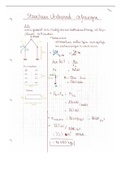Resume
Summary Data Engineering
- Cours
- Data Engineering
- Établissement
- Universiteit Antwerpen (UA)
This summary Data Engineering contains the course material with extra notes in grey and is made in the year including my answers for the example exam and example questions during the course. Also contains questions of exam itself. This document is very handy to learn in a structured way (highly st...
[Montrer plus]












